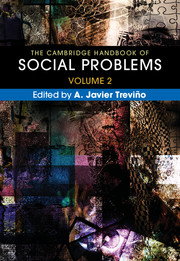Book contents
- The Cambridge Handbook of Social Problems
- The Cambridge Handbook of Social Problems
- Copyright page
- Contents
- About the Contributors
- Introduction
- Part I Problems Related to Health, Safety, and Security
- Part II Problems Related to Crime and Violence
- Part III Problems of Global Impact
- Chapter 27 Urbanism and Urbanization
- Chapter 28 Technology and Social Problems
- Chapter 29 Population and Contemporary Social Problems
- Chapter 30 Environmental Problems
- Index
- References
Chapter 30 - Environmental Problems
from Part III - Problems of Global Impact
Published online by Cambridge University Press: 16 March 2018
- The Cambridge Handbook of Social Problems
- The Cambridge Handbook of Social Problems
- Copyright page
- Contents
- About the Contributors
- Introduction
- Part I Problems Related to Health, Safety, and Security
- Part II Problems Related to Crime and Violence
- Part III Problems of Global Impact
- Chapter 27 Urbanism and Urbanization
- Chapter 28 Technology and Social Problems
- Chapter 29 Population and Contemporary Social Problems
- Chapter 30 Environmental Problems
- Index
- References
Summary
This chapter examines environmental problems from a sociological perspective. It traces the evolution of the two most prominent sociological approaches to conceptualizing environmental problems: realism and constructivism. Realists analyze environmental problems in terms of material changes to the environment that disrupt biophysical and social processes. Constructivists focus on the ways in which social, cultural, and political forces produce shared subjective perceptions of environmental problems. In comparing these two perspectives, this chapter illustrates the need for both realist and constructivist conceptualizations to account for the dialectical relationship between the social and biophysical forces that constitute environmental problems. This is further complicated in the examination of environmental problems in a global context. The chapter concludes by suggesting an approach to studying environmental problems that accounts for the relationship between local and global dynamics of socioenvironmental dialectics: a place-based sociology of environmental problems.
- Type
- Chapter
- Information
- The Cambridge Handbook of Social Problems , pp. 519 - 540Publisher: Cambridge University PressPrint publication year: 2018
References
- 2
- Cited by



